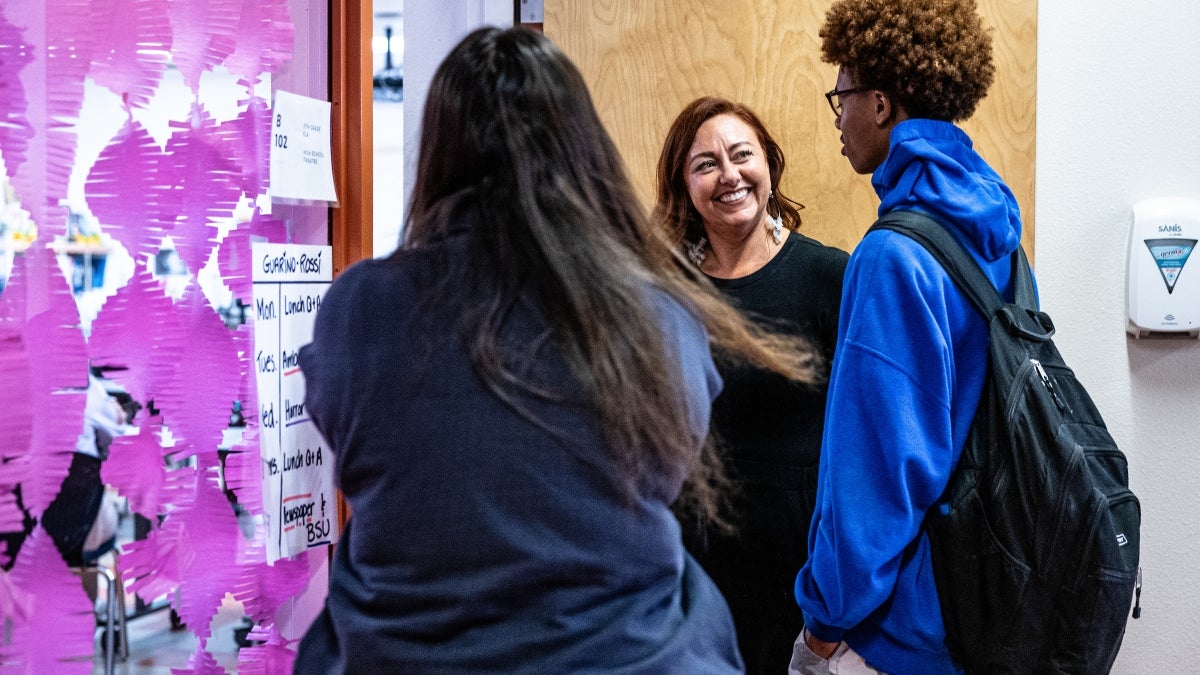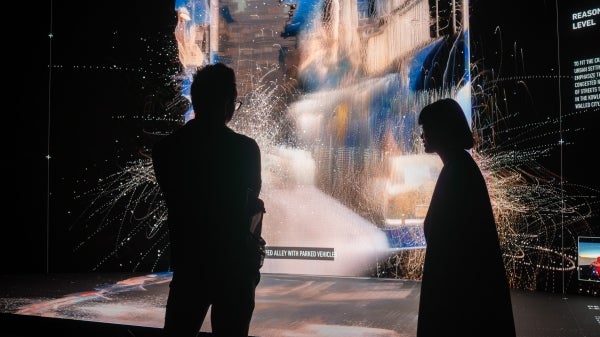No argument: ASU-led project improves high school students' writing skills

Ginette Rossi has implemented the Pathway Project tools in her English classroom at the Arizona School for the Arts to great success. Photo by Charlie Leight/ASU News
Students in the freshman English class at Phoenix Trevor G. Browne High School often pop the question to teacher Rocio Rivas.
No, not that one.
This one:
“How is this going to help me?”
When Rivas introduced the Pathway to Academic Success Project to her students — the project is designed to improve students’ reading and argument writing skills — she answered in the most practical way she could think of.
“Maybe you want to get a promotion and you need to find specific reasons to defend why you deserve that promotion,” Rivas said. “It’s important to be able to express your beliefs and find evidence to prove your idea. Take a stance and own it. Own your greatness.”
The Pathway Project, led in part by Arizona State University English Professor Jessica Early, was born out of a grant from the Department of Education.
Early, director of the Central Arizona Writing Project at ASU, helped direct an eight-state professional development program for secondary English language arts teachers to improve instruction on argument writing using cognitive strategies, which uses a “tool kit” approach to writing through planning and goal setting, making predictions or forming interpretations.
The impact of the project was significant. In 2023, students’ argument essays were scored on a six-point scale. The lowest combined score a student could be given was a two; the highest was a 12. On that 11-point range, a growth of one point was the equivalent of half a letter grade (from a B to an A-, for example). All of the classes grew at least one point — blind scored — and some classes grew by more than 2.73 points.
More generally, the students showed improvement in overall writing quality, content, stance (taking a side or making a case), conventions (e.g., mechanics, spelling, grammar, clarity) and productivity.
“It really transformed their literacy experiences,” Rivas said. “I think often, especially here in this community, so many students have negative experiences with learning English because they’re multilingual learners and they can’t really grasp abstract concepts. The Pathway Project really simplifies each cognitive step and presents it in a way for the students to understand, and it doesn’t complicate it too much. It really is an incredible project.”
Argument writing crosses all genres. ... It's what we do in the world.
Jessica EarlyASU English professor
Early’s Arizona leadership team consisted of Ginette Rossi, an ASU PhD student in English education and teacher at the Arizona School for the Arts; Ashley Yap, who graduated from ASU with a master's degree in English education and is a teacher at Chandler High School; and Rosanne Walker, a teacher at ASU Preparatory Academy.
“These are some of the best teachers in the state who graduated from our program, and who are now coming back to lead,” Early said.
The team was trained in the cognitive strategies of the Pathway Project, tested them out in their own classrooms in 2020, the first year of the grant, and then worked with more than 30 teachers from four schools in the Phoenix Union High School District: Carl Hayden, Trevor G. Browne, Alhambra and Maryvale.
Early, who co-authored a research article on the project in the Journal of Educational Psychology, said argument writing is an essential skill for secondary students as they move on to college and their careers.
“Argument writing crosses all genres,” Early said. “It can be a college admission essay, which is an argument making a case for who you want to be in college and why you want to get in. Argument writing can be an op-ed piece. If you’re an attorney, you write arguments.
“In almost all of the classes at ASU, students are writing in some way, whether it’s a proposal, engineering, art. My husband is an artist, and he writes grants to get his funding. It’s what we do in the world.”
Rossi said she believes one of the reasons Pathway is successful in improving students’ writing skills is that it’s not a black-and-white teaching method. Teachers can adapt the material to best fit the students they’re teaching.
“We were giving them different ways that you can incorporate the strategy so that it didn’t seem so cut and dry, like it had to be this way all the time,” Rossi said. “I think a lot of times scripted is what teachers are comfortable with. That’s great, but it doesn’t mean that it meets the makeup of every child.”
Rossi used a Pathways cognitive strategy to improve students’ experience at “Book Bistro,” a reading experience she created at Arizona School for the Arts in Phoenix.
At Book Bistro, Rossi’s students could read anything — novels, short stories, magazines, recipes, even comic books — as long as each reading assignment lasted at least 20 minutes and they were reading three different pieces each quarter. At the end of each quarter, they got together in a coffeehouse-style atmosphere to talk about what they had read and celebrate the accomplishment.
One of the Pathway strategies Rivas uses when teaching argumentative analysis writing is color coding. Summary sentences are in yellow because, like the sun, they’re bright as day and the basic facts of the story. Pieces of evidence are in green because those are the “money pieces” that will build the argument. Interpretations and original thoughts are in deep blue.
Related story
ASU doctoral student wins Arizona K–12 educator award: Ginette Rossi's Book Bistro encourages students to read
“It guides them through how to introduce, cite and explain. It also provides sentence starters, and we rely on those sentence starters. So, it gives us all the tools to craft an argument.”
Rivas said Pathway has been instrumental in her development as a teacher.
“I was in my first year of teaching when I started using it,” she said, “and it’s kind of carried with me throughout all my years of teaching. And because I can implement new things, it just gets better and better every year.”
More Arts, humanities and education
Annual art exhibit by incarcerated community raises $18K for scholarship
An annual exhibition of art created by people who are incarcerated in Arizona sold 200 pieces on May 16, raising more than $18,000 for a yearly Arizona State University scholarship.This year’s show…

ASU students, faculty transform MIX Center into a living canvas of immersive design
On April 30, Arizona State University’s Media and Immersive eXperience (MIX) Center in downtown Mesa welcomed nearly 600 guests to MIXibition Spring 2025 — a multisensory showcase of immersive…

ASU honors student selected for prestigious Fulbright UK Summer Institute
Rei Tedoco is one of only 31 students in the United States to be selected by the US-UK Fulbright Commission to participate in the Fulbright Summer Institute on British Cultural Heritage at the…

